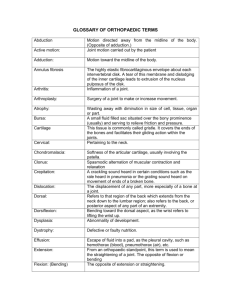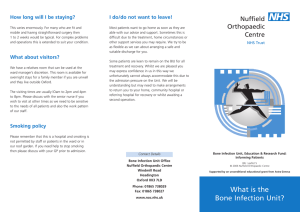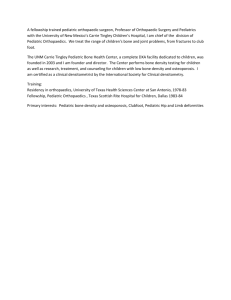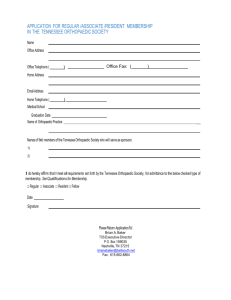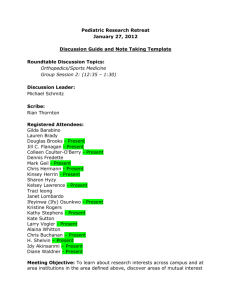Report - Anatomical Society
advertisement
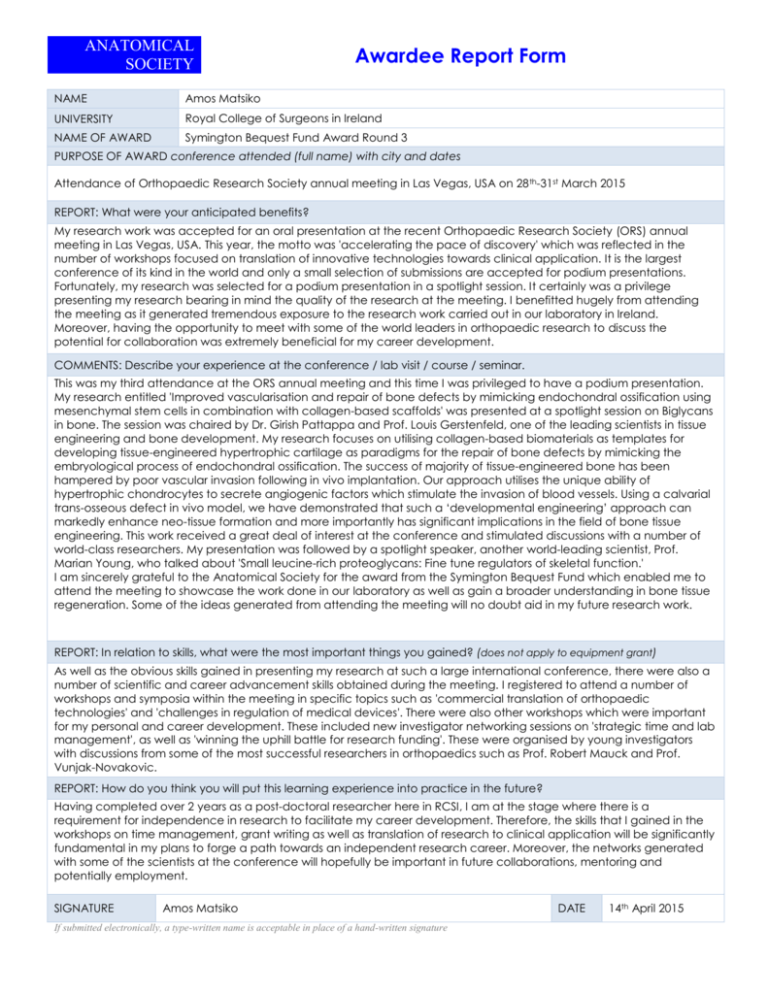
ANATOMICAL SOCIETY Awardee Report Form NAME Amos Matsiko UNIVERSITY Royal College of Surgeons in Ireland NAME OF AWARD Symington Bequest Fund Award Round 3 PURPOSE OF AWARD conference attended (full name) with city and dates Attendance of Orthopaedic Research Society annual meeting in Las Vegas, USA on 28 th-31st March 2015 REPORT: What were your anticipated benefits? My research work was accepted for an oral presentation at the recent Orthopaedic Research Society (ORS) annual meeting in Las Vegas, USA. This year, the motto was 'accelerating the pace of discovery' which was reflected in the number of workshops focused on translation of innovative technologies towards clinical application. It is the largest conference of its kind in the world and only a small selection of submissions are accepted for podium presentations. Fortunately, my research was selected for a podium presentation in a spotlight session. It certainly was a privilege presenting my research bearing in mind the quality of the research at the meeting. I benefitted hugely from attending the meeting as it generated tremendous exposure to the research work carried out in our laboratory in Ireland. Moreover, having the opportunity to meet with some of the world leaders in orthopaedic research to discuss the potential for collaboration was extremely beneficial for my career development. COMMENTS: Describe your experience at the conference / lab visit / course / seminar. This was my third attendance at the ORS annual meeting and this time I was privileged to have a podium presentation. My research entitled 'Improved vascularisation and repair of bone defects by mimicking endochondral ossification using mesenchymal stem cells in combination with collagen-based scaffolds' was presented at a spotlight session on Biglycans in bone. The session was chaired by Dr. Girish Pattappa and Prof. Louis Gerstenfeld, one of the leading scientists in tissue engineering and bone development. My research focuses on utilising collagen-based biomaterials as templates for developing tissue-engineered hypertrophic cartilage as paradigms for the repair of bone defects by mimicking the embryological process of endochondral ossification. The success of majority of tissue-engineered bone has been hampered by poor vascular invasion following in vivo implantation. Our approach utilises the unique ability of hypertrophic chondrocytes to secrete angiogenic factors which stimulate the invasion of blood vessels. Using a calvarial trans-osseous defect in vivo model, we have demonstrated that such a ‘developmental engineering’ approach can markedly enhance neo-tissue formation and more importantly has significant implications in the field of bone tissue engineering. This work received a great deal of interest at the conference and stimulated discussions with a number of world-class researchers. My presentation was followed by a spotlight speaker, another world-leading scientist, Prof. Marian Young, who talked about 'Small leucine-rich proteoglycans: Fine tune regulators of skeletal function.' I am sincerely grateful to the Anatomical Society for the award from the Symington Bequest Fund which enabled me to attend the meeting to showcase the work done in our laboratory as well as gain a broader understanding in bone tissue regeneration. Some of the ideas generated from attending the meeting will no doubt aid in my future research work. REPORT: In relation to skills, what were the most important things you gained? (does not apply to equipment grant) As well as the obvious skills gained in presenting my research at such a large international conference, there were also a number of scientific and career advancement skills obtained during the meeting. I registered to attend a number of workshops and symposia within the meeting in specific topics such as 'commercial translation of orthopaedic technologies' and 'challenges in regulation of medical devices'. There were also other workshops which were important for my personal and career development. These included new investigator networking sessions on 'strategic time and lab management', as well as 'winning the uphill battle for research funding'. These were organised by young investigators with discussions from some of the most successful researchers in orthopaedics such as Prof. Robert Mauck and Prof. Vunjak-Novakovic. REPORT: How do you think you will put this learning experience into practice in the future? Having completed over 2 years as a post-doctoral researcher here in RCSI, I am at the stage where there is a requirement for independence in research to facilitate my career development. Therefore, the skills that I gained in the workshops on time management, grant writing as well as translation of research to clinical application will be significantly fundamental in my plans to forge a path towards an independent research career. Moreover, the networks generated with some of the scientists at the conference will hopefully be important in future collaborations, mentoring and potentially employment. SIGNATURE Amos Matsiko If submitted electronically, a type-written name is acceptable in place of a hand-written signature DATE 14th April 2015


